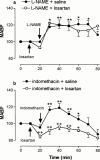Angiotensin II is involved in nitric oxide synthase and cyclo-oxygenase inhibition-induced leukocyte-endothelial cell interactions in vivo
- PMID: 11159720
- PMCID: PMC1572608
- DOI: 10.1038/sj.bjp.0703867
Angiotensin II is involved in nitric oxide synthase and cyclo-oxygenase inhibition-induced leukocyte-endothelial cell interactions in vivo
Abstract
1. Chronic inhibition of nitric oxide synthase (NOS) provokes a hypertensive state which has been shown to be angiotensin II (Ang-II) dependent. In addition to raising blood pressure, NOS inhibition also causes leukocyte adhesion. The present study was designed to define the role of Ang-II in hypertension and in the leukocyte-endothelial cell interactions induced by acute NOS or cyclo-oxygenase (COX) inhibition using intravital microscopy within the rat mesenteric microcirculation. 2. While pretreatment with an Ang-II AT(1) receptor antagonist (losartan) reversed the prompt increase in mean arterial blood pressure (MABP) caused by indomethacin, it had no effect on the increase evoked by systemic L-NAME administration. 3. Pretreatment with losartan inhibited the leukocyte rolling flux, adhesion and emigration which occurs after 60 min NOS inhibition by 83, 80 and 70% respectively, and returned leukocyte rolling velocity to basal levels. 4. Losartan significantly reduced the leukocyte-endothelial cell interaction elicited by COX inhibition. In contrast, leukocyte recruitment induced by acute mast cell activation was not inhibited by losartan. 5. AT(1) receptor blockade also prevented the drop in haemodynamic parameters such as mean red blood cell velocity (V(mean)) and shear rate caused by NOS and COX inhibition. 6. In this study, we have demonstrated a clear role for Ang-II in the leukocyte-endothelial cell interactions and haemodynamic changes which arise in the absence of NO or prostacyclin (PGI(2)). This is of interest since leukocyte recruitment, which culminates in the vascular lesions that occur in hypertension, atherosclerosis and myocardial ischemia-reperfusion injury, might be prevented using AT(1) Ang-II receptor antagonists.
Figures




References
-
- AKASU M., URATA H., KINOSHITA A., SASAGURI M., IDEISHI M., ARAKAWA K. Differences in tissue angiotensin II-forming pathways by species and organs in vitro. Hypertension. 1998;32:514–520. - PubMed
-
- ALDERMAN M.H., MADHAVAN S., OOI W.L., COHEN H., SEALEY J.E., LARAGH J.H. Association of the renin-sodium profile with the risk of myocardial infarction in patients with hypertension. N. Engl. J. Med. 1991;324:1098–1104. - PubMed
-
- ARNDT H., RUSSELL J.B., KUROSE I., KUBES P., GRANGER D.N. Mediators of leukocyte adhesion in rat mesenteric venules elicited by inhibition of nitric oxide synthesis. Gastroenterology. 1993;105:675–680. - PubMed
-
- BADIMON J.J., FUSTER V., CHESEBRO J.H., BADIMON L. Coronary atherosclerosis. A multifactorial disease. Circulation. 1993;87:II3–II16. - PubMed
-
- CHOBANIAN A.V., ALEXANDER R.W. Exacerbation of atherosclerosis by hypertension. Potential mechanisms and clinical implications. Arch. Intern. Med. 1996;156:1952–1956. - PubMed
Publication types
MeSH terms
Substances
LinkOut - more resources
Full Text Sources
Research Materials
Miscellaneous

